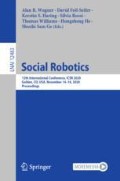Abstract
Based on the assumption that humans align linguistically to their interlocutor, the present research investigates if linguistic alignment towards an artificial tutor can enhance language skills and which factors might drive this effect. A 2 \(\times \) 2 between-subjects design study examined the effect of an artificial tutor’s embodiment (robot vs. virtual agent) and behavior (meaningful nonverbal behavior vs. idle behavior) on linguistic alignment, learning outcome and interaction perception. While embodiment and nonverbal behavior affects the perception of the tutor and the interaction with it, no effect on users’ linguistic alignment was found nor an effect on users learning outcomes.
Access this chapter
Tax calculation will be finalised at checkout
Purchases are for personal use only
References
Atkinson, D., Churchill, E., Nishino, T., Okada, H.: Alignment and interaction in a sociocognitive approach to second language acquisition. Mod. Lang. J. 91(2), 169–188 (2007). https://doi.org/10.1111/j.1540-4781.2007.00539.x
Bartneck, C.: Interacting with an embodied emotional character. In: Forlizzi, J., Hanington, B. (eds.) Proceedings of the 2003 international conference on Designing pleasurable products and interfaces, p. 55. ACM, New York, NY (2003). https://doi.org/10.1145/782896.782911
Bergmann, K., Branigan, H.P., Kopp, S.: Exploring the alignment space. Lexical and gestural alignment with real and virtual humans. Front. ICT 2 (2015). https://doi.org/10.3389/fict.2015.00007
Branigan, H.P., Pickering, M.J., Cleland, A.A.: Syntactic co-ordination in dialogue. Cognition 75(2), B13–B25 (2000). https://doi.org/10.1016/S0010-0277(99)00081-5
Branigan, H.P., Pickering, M.J., Pearson, J., McLean, J.F.: Linguistic alignment between people and computers. J. Pragmatics 42(9), 2355–2368 (2010). https://doi.org/10.1016/j.pragma.2009.12.012
Brennan, S.E., Clark, H.H.: Conceptual pacts and lexical choice in conversation. J. Exp. Psychol. Learn. Memory Cogn. 22(6), 1482–1493 (1996). https://doi.org/10.1037/0278-7393.22.6.1482
Fasola, J., Mataric, M.: A socially assistive robot exercise coach for the elderly. J. Hum.-Robot Interact. 2(2) (2013). https://doi.org/10.5898/JHRI.2.2.Fasola
Fischer, K., Lohan, K.S., Foth, K.: Levels of embodiment. In: Yanco, H. (ed.) Proceedings of the seventh annual ACMIEEE International Conference on Human-Robot Interaction, p. 463. ACM, New York, NY (2012). https://doi.org/10.1145/2157689.2157839
Giles, H.: Accent mobility: a model and some data. Anthropol. Linguist. 15, 87–105 (1973)
Hoffmann, L., Bock, N., Rosenthal von der Pütten, A.M.: The peculiarities of robot embodiment (EmCorp-Scale). In: Kanda, T., Abanović, S., Hoffman, G., Tapus, A. (eds.) HRI’18, 5–8 March 2018, Chicago, IL, USA, pp. 370–378. ACM, New York, NY, USA (2018). https://doi.org/10.1145/3171221.3171242
Hoffmann, L., Krämer, N.C.: Investigating the effects of physical and virtual embodiment in task-oriented and conversational contexts. Int. J. Hum.-Comput. Stud. 71(7–8), 763–774 (2013). https://doi.org/10.1016/j.ijhcs.2013.04.007
Kidd, C.D., Breazeal, C.: Effect of a robot on user perceptions. In: 2004 IEEE/RSJ International Conference on Intelligent Robots and Systems (IROS), pp. 3559–3564. IEEE, Piscataway, N.J (2004). https://doi.org/10.1109/IROS.2004.1389967
Kiesler, S., Powers, A., Fussell, S.R., Torrey, C.: Anthropomorphic interactions with a robot and robot-like agent. Social Cogn. 26(2), 169–181 (2008). https://doi.org/10.1521/soco.2008.26.2.169
Li, J.: The benefit of being physically present: a survey of experimental works comparing copresent robots, telepresent robots and virtual agents. Int. J. Hum.-Comput. Stud. 77, 23–37 (2015). https://doi.org/10.1016/j.ijhcs.2015.01.001
Rosenthal-von der Pütten, A.M., Krämer, N.C., Herrmann, J.: The effects of humanlike and robot-specific affective nonverbal behavior on perception, emotion, and behavior. Int. J. Soc. Robot. 10(5), 569–582 (2018). https://doi.org/10.1007/s12369-018-0466-7
Rosenthal-von der Pütten, A.M., Straßmann, C., Krämer, N.C.: Robots or agents – neither helps you more or less during second language acquisition. In: Traum, D., Swartout, W., Khooshabeh, P., Kopp, S., Scherer, S., Leuski, A. (eds.) IVA 2016. LNCS (LNAI), vol. 10011, pp. 256–268. Springer, Cham (2016). https://doi.org/10.1007/978-3-319-47665-0_23
Wunderlich, H.: Talking like a machine?! Linguistic alignment of native-speakers and non-native speakers in interaction with a virtual agent. Bachelor Thesis, University of Duisburg-Essen (2012)
Author information
Authors and Affiliations
Corresponding author
Editor information
Editors and Affiliations
Rights and permissions
Copyright information
© 2020 Springer Nature Switzerland AG
About this paper
Cite this paper
Rosenthal-von der Pütten, A., Straßmann, C., Krämer, N. (2020). Language Learning with Artificial Entities: Effects of an Artificial Tutor’s Embodiment and Behavior on Users’ Alignment and Evaluation. In: Wagner, A.R., et al. Social Robotics. ICSR 2020. Lecture Notes in Computer Science(), vol 12483. Springer, Cham. https://doi.org/10.1007/978-3-030-62056-1_9
Download citation
DOI: https://doi.org/10.1007/978-3-030-62056-1_9
Published:
Publisher Name: Springer, Cham
Print ISBN: 978-3-030-62055-4
Online ISBN: 978-3-030-62056-1
eBook Packages: Computer ScienceComputer Science (R0)

